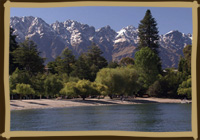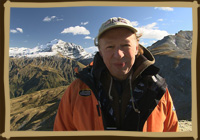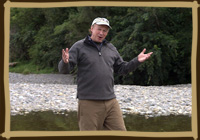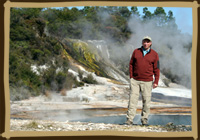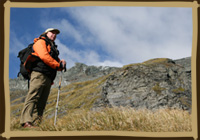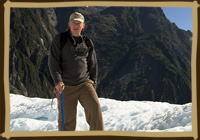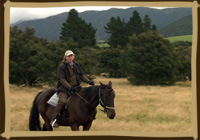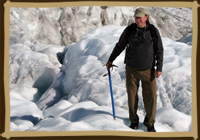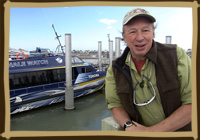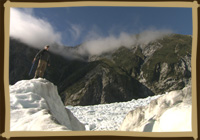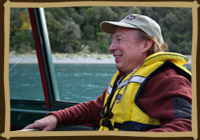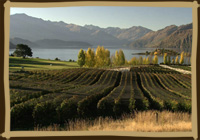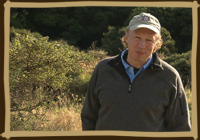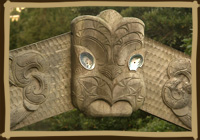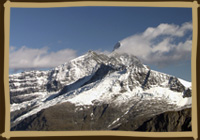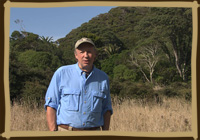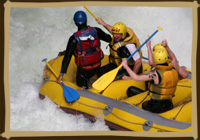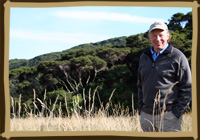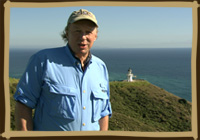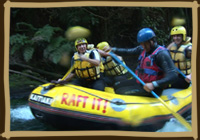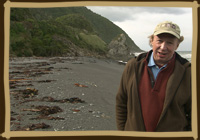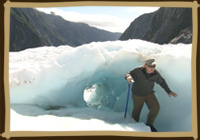
Richard On-Camera: Near the southernmost reaches of civilization, in a down under world with an upright world-view…. a place called New Zealand. The massive lands of the Northern Hemisphere may tip the scales with their acreage, but today small New Zealand is proving to be more than good balance. It’s become a model for the world in its pursuit of a sustainable environment.
Richard Voice-Over: Join us as we traverse the most physically and climatically diverse landmass in Polynesia, this adventure-packed country at the bottom of the earth, in search of an age-old Maori concept that might hold a key to our planet’s future survival.
R OC: I’ve been to New Zealand many times, but I keep finding reasons to return …there is something irresistible about its natural beauty, something ever-alluring about its deep culture; and something enigmatic about how it seems more pristine with each visit.
R VO: New Zealand was the last major landmass settled by humans, by men and women in stout canoes who traveled thousands of miles across the Pacific. The descendents of those early Polynesian explorers, known as Maori, developed their own mythology and value system to help them survive in this mystifying new world.
R OC: Now, I’m setting off to seek some modern answers rooted in indigenous wisdom, hoping to unearth the meaning and origins of something Maori call “Kaitiakitanga”.
R VO: This complex cultural guideline evokes something like “caretaking” or “guardianship.” It’s difficult for non-Maori to fully understand, but an important element of “Kaitiakitanga” is a responsibility human beings have to protect the physical world, including the land, seas and skies.
Maori cultural expert, John Panoho, provides some pieces to this puzzle and helps me craft my quest.
Richard: “So John, how do I find out what this concept Kaitiakitanga means and why it works here?"
John: “You have to come with an open mind. You have to connect with Maori people in all walks of life as you travel through the country and get a sense of how they perceive themselves to be kaitiaki. You are delving into another realm of course, you’re delving into a spiritual realm, really. In the Maori world, everything is descended from a supreme being, everything has its own life force, everything. And probably if you went to Te Reinga, to the spirit tree in the far north you’d probably come to some understanding of what it all means.”
R OC: What’s old is new. Today’s Kiwis, people of both European and Maori descent, are promoting the idea that the knowledge of the ancients may be the secret to the preservation of our planet, for our children and our children’s children. As I travel 1000 miles, the length of New Zealand, I hope to decode the meaning of “kaitiakatanga”.
R VO: I’ll try to discover why today there’s an enthusiastic new wave of promoters of this age-old concept, and see how its practice is playing out in modern New Zealand.
On this journey, we’ll begin in the south, in Mt. Aspiring National Park. We’ll navigate north to the Franz Joseph Glacier and on to the town of Kaikoura. We’ll cross the Cook Strait to the North Island, stopping in Wellington,…the Taupo region,… and Hokianga Harbor. Finally, we’ll arrive on the upper tip of New Zealand, where there is a great tangled tree of Maori legend.
Why do we travel? Excitement, adventure, to recapture that spark of childlike wonder…
R OC: Perhaps to expand awareness, or to put ourselves in the middle of our own unfolding myths? As conscientious travelers we’ve become increasingly concerned about how our tourism dollars are spent. And about our own impact on the environment, and yes the threat of global climate change.
R VO: ‘A tool of the Gods’ – that’s how the Maori viewed Mount Aspiring, this stunning peak in the southern alps where I begin this exploration. With rugged contours reminiscent of the Matterhorn, Mount Aspiring is an adventure seeker’s dream. Maori call it Tititea, or "glittering peak." According to legend, a god used this peak as a tool to gouge out the coastal fjords of the South Island. Here it sits; upended and abandoned. But pure bliss for modern walkers and mountaineers.
Maori have place names for everything, and behind every name is a story. Before contact with the paler civilizations, Maori had no written language, so story-telling was essential to continue the culture.
R OC: And figuring prominently in many of these stories were the landscapes as characters. To the Maori, the landscapes are alive, and taking care of them is as important as taking care of one’s own family.
R VO: Amidst this vast expanse of wild, rugged scenery sits one lone structure: the Whare Kea Chalet. Hardcore adventurer travelers can make the several-day hike in to this loft, though most come by helicopter. What appears from the outside to be a simple mountain cabin is inside a very cushy retreat, designed for minimal impact on the environment.
Richard: “I’ve stayed in a lot of mountain huts in my day, but I’ve never seen anything quite like this.
Steven: “Yeah, this is kind of special isn’t it, it’s one out the box, this one.
R: “It’s designed for comfort.”
S: “It is, it is indeed.”
R: “I’ve heard the term eco-lodge, but this is like an eco-chalet?”
S: “It’s eco-friendly for sure. With all the water that’s collected off the roof, and all toilet waste is flown out by helicopter so there’s nothing left here in the environment. And all the electricity is by solar and wind turbine.”
R VO: There were mountaineers who believed that this site, on the edge of the national park, should be kept free of development. To address such concerns, strict environmental measures were imposed.
Richard: “So this is pure wilderness, a hundred percent pure wilderness.”
S: “Yeah, its all Mt. Aspiring National Park we can see out the windows there.
R: “So, we’re probably the only people for miles.”
S: “Yeah, literally. Literally miles.”
R VO: The nearby town of Wanaka is a gathering place for the intrepid from around the world seeking their own tales of adventure. Surrounded by mountains and water, this is an ideal launching pad for a glut of outdoor activities. The wildly diverse southern terrain is within easy reach, and wilderness enthusiasts can take on nearly any physical thrill imaginable, and some unimaginable.
Boat lovers have a wealth of options. A laidback tour of serene Lake Wanaka offers transcendent vistas.
Those looking for an adrenaline boost can head out of town for a classic jet boat ride. Jet boats were invented by New Zealander Bill Hamilton. Hamilton wanted a craft that could operate in the shallow, fast-flowing rivers of New Zealand. Because these boats have no external rotating parts, they pose fewer hazards for swimmers and marine life. But the use of jet boats is controversial among a set of adventure travelers. Some decry the fuel consumption and noise, while others argue that this kind of transport takes the elitism out of adventure travel by making the wilderness accessible to people of any age, shape, or income. They claim that the more people who can be touched by the magic of the outdoors, the larger the constituency to raise voices when the environment become threatened.
New Zealand certainly packs a scenic punch for adventure travelers. But can outsiders understand the deep feelings Maori have for this landscape?
Kylie: “For Maori, we are the land and the land is us, that’s just what we believe. We connect with the land, whenever we introduce ourselves, it’s all about where we’re from. The last thing we say is our name because where we’re from and the place that we connect to is our mountains and our rivers, because our mountains and our rivers are our people.”
R VO: Maori believe that the two main islands of New Zealand were created by the demi-god, Maui. As a boy, he hid in the back of a “waka” or canoe that his older brothers used for fishing.
Kylie: “When they turned their backs to continue fishing, he cast his magic hook out into the ocean. And no sooner had it hit the water then he got this massive bite.”
R VO: Maui wrestled a giant fish to the surface, causing their canoe to flip over.
Maori believe that that giant fish became the North Island of New Zealand. Wellington, at the bottom, is the head of the fish. And the brothers’ overturned waka became the South Island, where we’re now standing.
Kylie: “And these mountains that you see, this is the keel of that boat.”
Richard: “That’s the bottom of the canoe.”
Kylie: “That’s the bottom of the canoe.”
R VO: While much of the scenic world has allowed resort development that ravages the land, shatters traditional culture, and spirits monies away from locals to overseas corporations, New Zealand has been a pioneer in embracing eco-friendly lodgings.
Located in the mountain town of Wanaka, the Wanaka Homestead shows that going green doesn’t necessarily conflict with luxury. The local builders and owners used recycled timber from farm sheds and innovative low-energy designs.
Roger: “We deliberately consume as little brought in power or brought in energy as possible, mostly though the passive qualities of the building and its orientation and insulation.”
R VO: They also use an integrated solar heating system for hot water, a hot tub and for under floor heating.
R: “So I think a lot of people when they think about accommodations that are environmentally sound, they think of yurts and mud huts and teepees, but this is pretty elegant.
Roger: “Well all those ways are valid. But we’re in a mainstream business here and we have mainstream customers primarily, and we didn’t want to compromise on luxury and we didn’t.”
R VO: he lodge is super well-insulated so the building loses almost no heat.
Roger: “We’ve got the low energy lights there even though they don’t look like low energy lights.
R: “Economically it’s a great argument why you should go this direction.”
Roger: “It personally drives me nuts that we constantly invent ways to generate more instead of invent ways to consume less. To me it’s a way forward. And with just a few tiny little efforts that we made our energy bills are half of what’s normal.”
R: “That’s wonderful.”
Roger: “Thank you.”
R OC: The term or prefix ‘eco’ has been stretched and bled and mangled and manipulated as a marketing tool. So it’s important that we as conscientious travelers ask the right questions when it comes to accommodations. Is the lodge environmentally sound? Is it energy efficient? Does it hire locals? And ultimately, where does our money go?
R VO: In New Zealand 60,000 visitors a year come to this tumbling poem called the Franz Josef glacier. Here one can test his fire against the flying ice and be a part of a moving myth.
R OC: There’s a reason there is such a great body of literature centered about mountains and glaciers. To traverse these landscapes is to be a part of a narrative, rich with risk, conflict, and perhaps understanding.
R VO: Glaciers are large masses of compacted snow and ice that flow downward under the pressure of their own weight. There are about 360 glaciers in New Zealand’s Southern Alps. Changes in weather rapidly affect Franz Josef because the valley here is so steep and the glacial flow unusually fast. Though it’s recently been advancing, or growing, due to local conditions, experts believe this is a temporary trend. Franz Josef, like all the world's ice rivers, has receded considerably since first tracked. Glacier ice represents the largest reservoir of fresh water on earth, and the intense acceleration in glacial melting over the past three decades bodes massive flooding, and threatens global drinking supplies.
Near the west coast town of Hokitika, I drop in for a visit with Maori elder Hemi Te Rakau.
He welcomes me with a traditional Maori greeting. I’m hoping Hemi can help me dig more deeply into the concept of kaitiakitanga.
Hemi: “Kaitiakitanga in a few words is a caring system for anything which is important for the nurture of a people, whether it be a food source, or a shelter, or a history, or a place. It’s something that needs to be cared for the greater good of the tribe or the community as a whole.
Richard: “I keep hearing that New Zealand is relatively unique to the rest of the world in that it’s endorsing this concept as a national ethos. Is that true?”
H: “I think it is in general. The world is ready listen a little more now to indigenous people and their belief systems, which are actually ecological systems. If you step back far enough, we all needed to sleep, have shelter and to eat. But I think the world is now looking back into balance, rather just commercialism and development, and I think that Maori because we think in that holistic way about our surroundings, even though we have electricity and we drive cars and we live in the 21st century with computers we can still exist in our minds in those olden days and keep those concepts and those places warm and alive.”
R OC: I keep coming back to the question, why here? The Maori were not saints. Before Europeans arrived, they deforested much of their land, and hunted several species to extinction. They were warriors and cannibals. But now, while much of the world is digging a deeper hole for itself, New Zealand is building a mountain of hope.
R VO: In the mid-19th century, when European settlement began in earnest, Maori culture was threatened by disease, foreign ideas and new technologies. By the 20th century, the culture came dangerously close to capsizing.
But one place where tradition and sustainable practices have triumphed is the dauntless town of Kaikoura, on the east coast of the South Island.
The town sits on a peninsula cradled by mountains and cavernous seas. Just as two cultures crashed together, European and Maori, two ocean currents converge here – one subtropical, the other subantarctic – making the waters rich in plankton and marine life.
For many years the town of Kaikoura struggled economically, and young Maori fled to larger cities for work. But by digging into their own myths the people of this peninsula have reinvented their home as a center of whale watching, prompting an economical revival, and attracting the young back to make a good living while honoring their heritage. A group of Maori founders took a big risk by mortgaging their homes to buy the first Whale Watch boat. The company is now the single largest employer in Kaikoura.
At one point, the whales here were hunted nearly to extinction. But now visitors from around the globe hunt with cameras, coming to catch a glimpse of one of these leviathans up close. Many cultures consider whales the embodiment of enormous power, and Maori traditionally saw them as protectors.
Kauahi: “There’s an old legend about a Maori warrior called Paikea and a whale called Tohura. Paikea come here on the back of a whale, and Maori from the very early days have had a lot of respect for the marine mammals, in particular the whales. But more today especially with the whale watch we see ourselves as the Kaitiakitanga and trying to look after these whales and again hopefully for future generations.”
Richard: “So they used to look after you, they were the guardians, but now you’re the guardians of the whales.”
Kauahi: “That’s how we like to see it nowadays.”
R OC: The story of Paikea and the whale represents a spiritual bond between humans and the natural world. It holds the promise of sustainable rewards that come when nature is revered instead of exploited.
R VO: Tragically, some of these same whales seen aboard Whale Watch tours may be killed by foreign commercial whalers once beyond the protection of New Zealand waters.
New Zealand, which broke away from the supercontinent of Gondwanaland some 100 million years ago, was encircled with sea creatures, but evolved without land mammals. Maori brought the first here: the dog and the Polynesian rat. In 1814 the British missionary Samuel Marsden introduced sheep, cattle, and horses. Maori were great adapters, and soon they were riding the ranges, coasts and passes on horseback, and it’s still a keen way to get close to this land.
R OC: Traveling this way, I have to say I regret the invention of the car.
R VO: European newcomers brought not only their own animals, but Christian morality, impenetrable laws, and intentions to colonize. Eventually the relentless encroachment by British settlers onto Maori land led to a series of land wars that intensified over decades, producing the greatest slaughter in the history of Polynesia. By the beginning of the twentieth century, the European population had grown to more than half a million, while Maori numbers shrank from 100,000 to fewer than 40,000.
Maori culture survived and is enjoying new currency and vibrancy today. For a closer look at how it shapes Kiwis’ relationship with the environment, I’m checking in with Maori Tours in Kaikoura. Here, on one of Kaikoura's bush walkways, the indigenous plants and trees of New Zealand riot before the eyes. More than three-quarters of native plants and trees are unique to New Zealand, and Maori devised novel ways to use these gifts of nature.
Kim: “This is called the koukou, also know as the New Zealand peppertree. This plant has around about 27 different medicinal purposes. It’s good for coughs and colds, drunken as a tea it purifies your blood.”
Maurice: “This is the tortora and as far as all of our plants and all of our trees go, this species of tree is our big chief.”
R VO: Maori relied on the strong wood of the tortora tree to carve their canoes, and create intricate works of art.
Maurice: “This particular tree here is about 500 years old. With our tribe even today if someone refers to you as a tortora, that is the highest compliment that can be given a person. And there’s a common saying amongst every tribe of New Zealand that when a respected elder dies, they say another tortora is fallen.”
R VO: According to Maurice, Maori believe everything in nature has a life force, and that everything is connected in a spiritual web.
Maurice: “Maori people are known as Tangata Whenua, which means people of the land. And I think that has rubbed off on the early settlers that came here. And there were a lot of injustices in those early times, but our country has taken it upon themselves to try to right the wrongs of the past, and righting the wrongs of the past draws you even closer together. You know the future with our country, it looks good. And as far as environmental things go, we lead the way.”
R VO: More and more Kiwis are using New Zealand’s natural attributes for another adventure with purpose—winemaking.
Kaikoura Winery sits high on a bluff with vineyards stretching down to the misty sea. The winery is recognized for its strong policies on sustainability, such as producing its signature grape from free-draining soils. The success of Whale Watch created a huge demand for more ecologically friendly activities, and Kaikoura, rose to the challenge with new lodges and services in that spirit. Ecotravelers now flock here to enjoy a bounty of natural delights, such as watching great pods of dusky dolphins perform their acrobatics around boats….gazing at the wings of albatross in flight …and admiring fur seals as they frolic along the shore.
Mayor: “This area is of huge historical significance to the Maori. They along with council and along with community realized the benefits of keeping our environment pristine, realized the benefits of ecotourism, economically and socially.”
R VO: Kaikoura is now the first community in the world to be benchmarked by Green Globe 21. Green Globe is a worldwide certification program for the tourism industry, and participants must have strong records in responsible social and environmental behavior.
Mayor: “So we’re very proud of that, and we can use it as a tool for our marketing. We can use it as a watchdog for ourselves. And that happens in our community, believe me.”
R VO: “How to give back?” It’s one of the questions conscientious travellers must ask themselves. The town of Kaikoura offers one constructive way to help offset the carbon footprint visitors make. Through the ‘Trees for Travellers’ program, a visitor can purchase a native tree, and plant it here to help reforest the region.
Steve. “A traveler like yourself will come into town and they will want to offset their carbon emissions, and they’ll buy a tree from a nursery and I’ll plant it.”
R. “Ok I gotta say I love this concept, I think it’s a brilliant concept and I want to plant my tree.”
Steve. “Dig your hole.”
R VO: I’ve chosen to plant a kauri tree, a majestic evergreen native to New Zealand.
R: “And this is a big tree?”
S: “Huge, and not only big, but long living.”
R: “So my grandchildren’s grandchildren and visit this tree.”
S: “That’s right, your grandchildren’s grandchildren’s grandchildren may travel back to earth to visit the tree. It’ll still be here.”
R VO: Because each tree is individually tagged, when I get home I’ll be able to monitor my tree’s progress over the internet.
R: “I’m feeling less guilty already.”
R OC: The Maori concept of Katiakitanga means more than just providing for children and grandchildren. Like a planted tree that thrives for centuries, Maori believe they have an obligation to nurture seeds that grow and prosper for generations.
R VO: The Maori name for New Zealand is Aotearoa, or “Land of the Long White Cloud”, as from the sea the spine of snow-capped mountains appeared as powdery billows.
From above, the country’s two main islands seem to sail the southern Pacific manned at the center by the capital, Wellington.
The great majority of Maori settled on the more temperate North Island, and so it is I now cross the Cook Strait to this more populated and myth-rich place, and to the capital city.
Dignified and gracefully designed with the contours of the land, Wellington is a cultural axis, and the political hub of New Zealand.
Not long ago overfishing took its toll, and an essential food and economic resource was almost drained away. Now, though, strict measures are in place to protect fish stock, and the deep harbor’s marine life is coming back.
Its iridescent swirl of intense blue and green makes the paua shell an icon of New Zealand. These shells are used in art and jewelry, often as eyes in Maori carvings, the carvings that tell the stories. The shells are associated with the stars – the eyes of ancestors that gaze down from the night sky. But this small group of mollusks is a sought-after food source as well. New Zealand's paua fishing is managed by strictly-enforced quotas, which allow only a set amount of paua to be harvested each year.
Paua appears on the menu of some of Wellington’s top-notch restaurants, such as Logan Brown.
Richard: “So what are we doing?”
Stephen: “Well you’re helping me make some paua, or some abalone, ravioli. So you can use the cookie cutter on those. This is a way, Richard, that we can use paua or abalone in the restaurant because at $120 a kilo you can’t exactly put a whole paua on the plate because it would cost a fortune.”
R: “Paua is a pretty scarce resource in most of the world, yet here in New Zealand I can eat it without guilt.”
S: “You know, we’re a little country, we’re at the bottom of the world and I think a lot of kiwis have traveled and have seen that certain stocks and oceans have been depleted. and as the other parts of the world the resources get depleted we’re understanding and realizing that we’ve got a chance here to really look after the resource.”
R: “So is this what they’d call a ‘paua lunch’?”
S: “Exactly, it is a ‘paua lunch’, absolutely“Well let’s try it before it gets cold. I think what’s happened, you know when I was a child and growing up, we used to harvest and take everything and it was a competition, the more you had the better a sportsman or the better a fisherman you were. And I think Kiwis and New Zealanders now, we take what we need and maybe a little bit for the neighbor next door and we understand that we must look after the resources if we want it to be, you know we all have children and if we want them to have the same experiences that we had growing up.”
R VO: In Wellington, this philosophy extends beyond the sea. The city is a center for threatened species management and organized efforts to protect native plant and animal life thrive here.
Dan Rollinson: “We’re going to head down to another site now, it’s a similar site to this. It’s a site that we revegetated three years ago and we’re going to do some more tree releasing.”
R VO: Travelers looking to get involved in hands-on conservation efforts can join the Global Volunteer Network. It’s an organization designed to help communities not just here but throughout the world.
D: “These guys are our NZ conservation volunteers. This area’s being reforested, revegetated for the last probably three years.”
R VO: While much of the world celebrates the individual, here community comes first. Volunteers not only work together, but also live in co-operative housing and share in the cooking and cleaning.
D: “At the moment they’re releasing the trees, which is a term we use which is basically removing the weeds from the trees that were planted. And to stop them being smothered and killed.”
R VO: This organization works closely with local Maori, who in turn felt the volunteers were doing such a good job preserving native lands that they decided to honor the group by appointing them with the name “Kaitiaki”.
D: “That was a privilege to be given that term. I think everybody really needs to take stock of what natural assets they have in their own backyard, whether it’s a local park, a national park and kind of do their bit to preserve what they do have.”
R VO: Kiwis have a passion for the outdoors and the hilly capital offers a serpentine network of bike trails for all skill levels. To check out a local approach to alternative energy, I’m taking a steep but scenic ride up to the Brooklyn wind turbine, perpetually painting the sky on a hill above windy Wellington. Installed as part of a research project in the early 90’s, these spinning blades have withstood some of the highest winds of any operational wind turbine in the world. It has now become a model for alternative energy projects in New Zealand and beyond.
Of course, not everyone here buys into the ‘clean green’ philosophy, and there are plenty of Kiwis willing to exploit the environment to make a buck. But New Zealand remains one of the top-ranked countries committed to environmental protection, and has announced plans to become the first carbon neutral country in the world. What is it about this place and its people that has inspired such a commitment to sustainability?
I go straight to the top, to Prime Minister Helen Clarke, for insight.
Helen Clark: “There’s increasingly an awareness that we have to co-exist with nature. Bear in mind that we’ve come from a past where we cut things down, dug things up and had quite a heavy footprint. Even so, because we’re relatively recently settled by any international standard we’re able to arrest that in time. That’s why we’ve still got 30% in parks and reserves. That’s why we’ve go so much unspoiled area and coastline. And it’s important to keep it that way.”
Richard: “Is there something about the Kiwi character that makes you believe that you’ll succeed with your environmental and cultural policies?”
H: “We like to be at the forefront of things that are good. And it’s my conviction that in the 21st century these compelling environmental challenges are going to dominate our politics, dominate our lives. And for me it’s a question of communicating how each one of us in our own lifestyles can do something to help solve the problem. We’ve got to break it down. Where you can start is in how we use energy, how you transport yourself, what you buy. Don’t buy tropical hardwoods unless you’re buying sustainably produced wood. We can make a lot of individual decisions which will make a difference to the world.”
R VO: New Zealand, an oceanic archipelago that evolved in isolation, was once the world’s greatest bird land. Now we have to leave the mainland and sail to the offshore oasis of Kapiti Island to see what was once in abundance.
The liquid notes of birds in song float throughout Kapiti. Just a few miles off the mainland, the island is alive with rare native bird and plant life. It’s almost like a trip back to the New Zealand of centuries ago.
R OC: Before humans arrived on these islands, birds had no natural predators, and as a result, an incredibly diverse range of species evolved here.
R VO: Early Maori settlers learned kaitiakitanga the hard way - they hunted several species of flightless birds to extinction. When the Europeans arrived in the early nineteenth century, they brought dozens of invasive mammal species that preyed on birds, including the shy kiwi bird for whom New Zealanders are nicknamed.
R OC: Over the past thousand years the kiwi bird population has declined by 99 percent, and experts say that without protection this beloved symbol of New Zealand would soon become extinct.
R VO: Kapiti Island remains a carefully protected nature reserve, and the amazing resurgence of birdlife here is the result of decades of careful management and hard work. Many of the country’s most endangered species are now thriving in this environment, free of predators.
John: “I think we’ve seen and realized that some of the mistakes have been made in New Zealand through the introduction of pests and predators. People just didn’t think about the consequences of introducing rats and introducing possums.”
R VO: New Zealand has lost more than half of its endemic birds--that is, birds unique to New Zealand that can never be returned. But there’s a lot of conservation and protective work going on across the country, and John believes, as far as the environment goes, there’s great promise. Kapiti Island is a brilliant example of what can happen.
J: “And just to give you what I think is a really graphic example of how things have changed here on Kapiti Island, last summer for the first time in my forty years of being on this place, we saw flocks of 200 wood pigeons at a time, 200 kin that had flocked together. That’s a site that very, very, very few New Zealanders see these days..”
R VO: The flax bush, which grows throughout New Zealand, has always been a staple of Maori culture. The plant’s sturdy fiber has countless uses and can be woven into clothing, baskets and rope.
To protect the plant, Maori take only the outer leaves of the flax and never cut out the center. It’s become a metaphor for sustainability.
J: “An ancient but still current proverb that goes with the use of the flax—the English translation goes something like: ‘Take away the heart of the flax bush and where will the bell bird sing.’
R VO: The next stop on this quest to the north is the eerie, otherworldly, landscape of Taupo.
Centuries ago, violent volcanic eruptions blasted the Taupo area. According to historians, one in the 2nd century AD was so large it turned the sky red as far north as Beijing and as far west as Rome. This whole area still simmers with low-level volcanic activity.
Jim: “This area is Wairakei Terraces. It was originally used by our people for its healing purposes. Geothermal water played a significant part for Maori people.”
R VO: Tribes with access to geothermal power used it for cooking, bathing, heating and healing. For European newcomers these waters were the original destination spa. Now they are a tourist draw, and a reason to learn Maori myths.
J: “We believe that the energy come from our ancestor called Ngatoroirangi, which we are direct descendents from. Our main goal here is to educate people, to educate them to also be guardians over what we have and understand it the way we understand it where we can’t separate ourselves from what we call Papatuanuku, God of Earth. We say we come from there, we’re made up from different particles of earth, as well as the plants. And when we go, we go back there.”
R VO: Wending north of Taupo, the Waikato River passes through more thermal areas. A boat ride across the river to the Orakai Korako site is like being transported through a magic glass into a steaming netherworld.
This is an expanse of bubbling mud pools, gushing geysers and infernal silica terraces. Because it’s off-the-beaten track, it’s less visited than New Zealand’s other thermal areas, but some claim it’s the country’s best.
As impressive as this geothermal area is, at one time it was even grander. A hydroelectric dam, constructed in the early 1960’s, flooded two-thirds of this area, covering dozens of geysers and hundreds of hot springs. Most Kiwis now think the dam was a mistake and grass-roots opposition led the government to suspend plans for future projects.
In the early 1800s, thanks to fierce Maori warriors and ruthless European traders, New Zealand had a reputation as the most dangerous place in the Pacific. It may not now be dangerous in the manner they imagined then, but it still packs a lot of thrills. Here among the seemingly peaceful canyons of the Kaituna River, adventurers can take a wet, wild, spirited raft ride. The journey spouts and plunges through land considered sacred to Maori. The outfitter, Kaitiaki Adventures, is the only rafting concern blessed with permission from the local tribe.
The river whirls by ancient cemeteries, tall trees and waterfalls with stories. In keeping with Maori tradition, the rafters always offer a prayer to acknowledge and honor the people and the land through which the journey passes.
(Interview with guide)
“The Maori people believe that everything around us is alive—the river, we are alive, the sky, the mountains, so we like to pay respects to Mother Nature and the way we do it is by a prayer...
(Prayer)
R VO: The rafters have found a way to balance the thrill of the moment with regard for the past - a way of enjoying the bounty of a wild river, but doing so with consideration and respect.
Leaving the boiling, bubbling central regions of Taupo and Rotorua, I head further north to the Waipoua Forest, Hokianga Harbor and the far northern tip of New Zealand, Cape Reinga where I aim to encounter the tree of myth that Maori hold so sacred.
Trees are often seen as symbols of strength, endurance, and a connection with the ages. For millions of years, majestic kauri forests covered New Zealand’s North Island.
Kauri wood is one of the world’s best building materials; the trunks can be cut into long wide planks of superb timber. Maori held all ancient trees in reverence and gave them names.
Stephen: “This guy’s called Tane Mahuta, the lord of the forest, and he’s special to all New Zealanders. He is the largest rainforest tree on earth. He’s over 2,000 years old so he’s been living in the time of Christ and he’s been living a thousand years before the first human set foot on this land. There are only four or five species of trees on earth that regularly live over 3,000 years and this is one of them.”
Richard: “That’s humbling. How much of this original forest still remains?”
S: “That’s the tragic thing. We only have one percent of the old growth forest left. It’s very sad. And so we’re working to recreate and extend the boundaries of the forest.”
R VO: The unusual scale-like bark of the trees gave rise to a legend about two Maori icons: the kauri tree and the whale. According to tradition, the kauri and the whale decided long ago to exchange skins. That’s why the bark of the kauri is scaly and full of resinous oil, and sperm whales have skin that is knobby and tree-like.
By the middle of the last century, the cutting of kauris for industry had devastated these forests, mowing them down like grass. But now conservation groups are working to replant these stands and restore their life-giving power.
Stephen: “You know Kauri they produce the greatest amount of carbon fixing of any ecosystem on earth. Twice as much as a normal, heavily timbered forest. And it’s partly because of this deep rich humus that we have in the ground. So this tree, this forest could actually make a difference for the entire planet if we were caretakers in a larger sense. I think that each place needs to think locally to have an impact globally. Imagine what North America could do by investing in South America and protecting the rainforest there.”
R VO: Many years have passed since fleets of Maori waka floated through beautiful Hokianga Harbor. But it remains an unspoiled treasure with rolling hills, small waterfront towns and a quiet pace of life. Hokianga, named by the great Maori ancestor Kupe, means “the spring of the world of light.” According to lore, Kupe was the first Polynesian to discover the islands of New Zealand.
After sailing around the North Island, and giving names to many places he visited, Kupe finally settled here in Hokianga. It’s easy to see why. The spectacular giant sand dunes seem to roll on forever, and visitors can get a rush sand boarding down these golden slopes.
Since Kupe, many generations of Maori lived here, fiercely guarding this harbor. One modern keeper is Koro Carman, who now celebrates his legacy and shares his culture by operating tours of Hokianga.
R: “So here I the far north of New Zealand, what does Kaitiakitanga mean?”
Koro: “I think I can summarize that up in one word and that word is ‘tomorrow’. While I don’t completely understand the concept of the word, what I do know is Kaitiakitanga is about fostering and managing so that we can benefit from that management tomorrow.”
R VO: The final destination in my quest is far, far to the northern tip of the country, a place called Cape Reinga, where a fabled tree bends into imagination and mythos.
This cape separates the Tasman Sea from the Pacific Ocean. Here, two immense bodies of water crash against one another, often violently. This is a place of extreme spiritual significance for Maori. According to tradition, the spirits of the dead travel to Cape Reinga on their journey to the afterlife.
Joyce: “This is the most important place for Maori. This is the place where Maori believe our spirits depart. This down here is our tree, our pohutakawa tree and this is where our spirits leave from Aotearoa or New Zealand.”
R VO: The remote, solitary spirit tree maintains its foothold against the continual onslaught of wind and sea - a tree that started from a small seed, and grew into a conduit to another life in the hereafter.
R OC: New Zealanders of all stripes struggled to survive the centuries, and often, unknowingly, bled the land that gave them sustenance, sometimes coming dangerously close to killing the goose that provided their golden nest.
R VO: Like a tree, the spirit of Kaitiakitanga starts with a seed and spreads outward…with small actions that take root and grow. Kiwis who embrace Kaitiakitanga as a lifestyle and worldview know they can lead by example, and by sharing their legends, stories and myths. They hope that as you travel you’ll gather your own stories, and when you leave New Zealand, you’ll become a hero in your own tale, and a story teller too.
R OC: Here at the northern end of New Zealand, the end of our journey, Maori believe their spirits return. And perhaps that’s why this land and its concept of caretaking is so worthy of consideration. Maori believe that all things have a life force – rivers, rocks, mountains and trees – and we all share in a common spirit. It is this idea – that we are all a part of nature and not separate from it, that allows the promise of many tomorrows. And that could be a lesson for the whole of the world.
R VO: Here’s what you can do to make a difference:
- Stay in accommodations that are truly eco-friendly.
- Patronize Green Globe certified businesses.
- Plant a tree.
- Visit New Zealand to see for yourself.
For more information and links, go to our website:
www.AdventuresWithPurpose.tv
